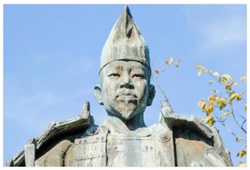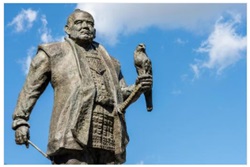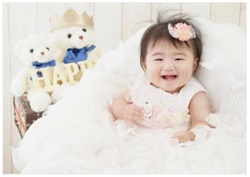Shogun is usually translated as “generalissimo.” It was originally a temporary title given by the emperor to the commander-in-chief of an expeditionary army.
Later, it developed into the official title given by the emperor to the administrative head of the country. The rule under the dictatorship of the shogun lasted until the mid-19th century.
Difinition of shogun by “Japan An Illustrated Encyclopedia”
An abbreviation of seii tai shougun, which is costomarily translated as “barbarian-subduing generalissimo”. Shoguns were in theory military military dictators whose regimes dominated the Japanese polity for most of Japanese history between 1192 and 1867.
During the Nara period(710-794), the imperial government ordered several expeditions against tribal groups known as the EZO, who occupied northeastern Honshu.
The most famous of the commanding generals, SAKANOUE NO TAMURAMARO, was designated seii tai shogun, one of several ancient titles bestowed on officials leading expeditions against insurgents or indigenous tribes.
Though the shogunal title fell into disuse once the border were quiet, it was resurrected four centuries later during the TAIRA-MINAMOTO WAR, when the brilliant warrior MINAMOTO NO YOSHINAKA drove the Taira leaders from Kyoto and appropriated for himself the title seii tai shogun.
After Yoshinaka’s death and the subsequent triumph of his cousin MINAMOTO NO YORITOMO in the civil wars, the emperor designated Yoritomo as shogun in 1192, giving him standing authority to undertake military action against anyone challenging his regime.


(The statue of Minamotono Yoritomo at the Genjiyama park in Kamakura city)
Yoritomo’s control over his own domains and vassals was thus legitimized, and he was given the right to appoint supervisory officials (JITO and SHUGO) over much of the country, creating the power base which sustained the KAMAKURA SHOGUNATE (1192-1333).
Yoritomo’s sons proved unable to dominate their powerful vassals, the HOJO FAMILY. The HOJO seized power and, after the Minamoto line died out, selected malleable Kyoto aristocrats to receive the title of shogun and become the figureheads of the shogunate they now controlled as regents.
The Hojo established the principle that the shogunal title be held only by a man who nominally headed a shogunate, a ruling millitary regime sanctioned by the emperor.
ASHIKAGA TAKAUJI, a military leader who helped destroy the Hojo regime, overcame oter rivals to establish the MUROMACHI SHOGUNATE (1338-1573) and claim the title of seii tai shogun.
For the next 30 years he and his son were constantly at war with rivals. From the 1370s, however, ASHIKAGA YOSHIMITSU and his successors were able to govern by maintaining an alliance with a few powerful regional warlords (SHUGO DAIMYO).
During the century after the ONIN WAR (1467-77), the shogunal position weakened as regional warriors (SENGOKU DAIMYOU) gained cotrol of more and more of the country. In 1573, the Ashikaga shogunate ceased to exist, its last shogun driven from Kyoto by ODA NOBUNAGA, the man who had earlier installed him.
Nobunaga and, later, TOYOTOMI HIDEYOSHI never sought the title of shogun. Both apparently accepted the tradition that the title, if not its power, was reserved for men of Minamoto desent, which neither could claim.
Years of civil war among regional warlords culminated in 1600 with a major battle at SEKIGAHARA. The triumphant TOKUGAWA IEYASU, tracing a tenuous link to Minamoto ancestors, accepted the title of shogun from the court. During the next century and a half, his descendants,the shoguns of the TOKUGAWA SHOGUNATE (1603-1867), were able to retain power by manipulating regional daimyo and their own vassals.

(a statue of Tokugawa Ieyasu at the Sunpu castle park)
However, the elaborate institutional structure, detailed regulations, and balancing mechanisms that held these groups in check also gradually deprived later shoguns of political flexibility, eventually creating a nearly powerless fgurehead. the opening of Japan to Western influence during the 19th century culminated in overturning the country’s political institutions and forcing the resignation of the last shogun, TOKUGAWA YOSHINOBU, in 1867.
Difinition of shogun and the Edo period
The Edo Period is the 260-year span following Tokugawa Ieyasu’s defeat of Toyotomi family and the establishment of a bakufu government in Edo (now Tokyo) in 1603.
The daimyo ranged from the Shogun, who sat at the apex of power, to lords controlling land worth over 10.000 koku (unit of measure based on rice production), and their domains and the power structure imposed on them were known as han.
The bakufu controlled the land and the people of the nation through these han units. This system of government is known as the bakuhan system.
(“Talking About Japan-Q&A” by Kodansha International p.88-90)

